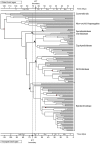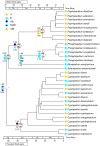Evolution and biogeography of the slipper orchids: Eocene vicariance of the conduplicate genera in the Old and New World Tropics
- PMID: 22685605
- PMCID: PMC3369861
- DOI: 10.1371/journal.pone.0038788
Evolution and biogeography of the slipper orchids: Eocene vicariance of the conduplicate genera in the Old and New World Tropics
Abstract
Intercontinental disjunctions between tropical regions, which harbor two-thirds of the flowering plants, have drawn great interest from biologists and biogeographers. Most previous studies on these distribution patterns focused on woody plants, and paid little attention to herbs. The Orchidaceae is one of the largest families of angiosperms, with a herbaceous habit and a high species diversity in the Tropics. Here we investigate the evolutionary and biogeographical history of the slipper orchids, which represents a monophyletic subfamily (Cypripedioideae) of the orchid family and comprises five genera that are disjunctly distributed in tropical to temperate regions. A relatively well-resolved and highly supported phylogeny of slipper orchids was reconstructed based on sequence analyses of six maternally inherited chloroplast and two low-copy nuclear genes (LFY and ACO). We found that the genus Cypripedium with a wide distribution in the northern temperate and subtropical zones diverged first, followed by Selenipedium endemic to South America, and finally conduplicate-leaved genera in the Tropics. Mexipedium and Phragmipedium from the neotropics are most closely related, and form a clade sister to Paphiopedilum from tropical Asia. According to molecular clock estimates, the genus Selenipedium originated in Palaeocene, while the most recent common ancestor of conduplicate-leaved slipper orchids could be dated back to the Eocene. Ancestral area reconstruction indicates that vicariance is responsible for the disjunct distribution of conduplicate slipper orchids in palaeotropical and neotropical regions. Our study sheds some light on mechanisms underlying generic and species diversification in the orchid family and tropical disjunctions of herbaceous plant groups. In addition, we suggest that the biogeographical study should sample both regional endemics and their widespread relatives.
Conflict of interest statement
Figures




References
-
- Prance GT. Floristic inventory of the tropics: Where do we stand? Ann Mo Bot Gard. 1977;64:659–684.
-
- Raven PH. Tropical floristics tomorrow. Taxon. 1988;37:549–560.
-
- Givnish TJ, Renner SS. Tropical intercontinental disjunctions: Gondwana breakup, immigration from the boreotropics, and transoceanic dispersal. Int J Plant Sci. 2004;165:S1–S6.
-
- Thorne R. Tropical plant disjunctions: a personal reflection. Int J Plant Sci. 2004;165:S137–S138.
-
- Upchurch P. Gondwanan break-up: legacies of a lost world? Trends Ecol Evol. 2008;23:229–236. - PubMed
Publication types
MeSH terms
Substances
Associated data
- Actions
- Actions
- Actions
- Actions
- Actions
- Actions
- Actions
- Actions
- Actions
- Actions
- Actions
- Actions
- Actions
- Actions
- Actions
- Actions
- Actions
- Actions
- Actions
- Actions
- Actions
- Actions
- Actions
- Actions
- Actions
- Actions
- Actions
- Actions
- Actions
- Actions
- Actions
- Actions
- Actions
- Actions
- Actions
- Actions
- Actions
- Actions
- Actions
- Actions
- Actions
- Actions
- Actions
- Actions
- Actions
- Actions
- Actions
- Actions
- Actions
- Actions
- Actions
- Actions
- Actions
- Actions
- Actions
- Actions
- Actions
- Actions
- Actions
- Actions
- Actions
- Actions
- Actions
- Actions
- Actions
- Actions
- Actions
- Actions
- Actions
- Actions
- Actions
- Actions
- Actions
- Actions
- Actions
- Actions
- Actions
- Actions
- Actions
- Actions
- Actions
- Actions
- Actions
- Actions
- Actions
- Actions
- Actions
- Actions
- Actions
- Actions
- Actions
- Actions
- Actions
- Actions
- Actions
- Actions
- Actions
- Actions
- Actions
- Actions
- Actions
- Actions
- Actions
- Actions
- Actions
- Actions
- Actions
- Actions
- Actions
- Actions
- Actions
- Actions
- Actions
- Actions
- Actions
- Actions
- Actions
- Actions
- Actions
- Actions
- Actions
- Actions
- Actions
- Actions
- Actions
- Actions
- Actions
- Actions
- Actions
- Actions
- Actions
- Actions
- Actions
- Actions
- Actions
- Actions
- Actions
- Actions
- Actions
- Actions
- Actions
- Actions
- Actions
- Actions
- Actions
- Actions
- Actions
- Actions
- Actions
- Actions
- Actions
- Actions
- Actions
- Actions
- Actions
- Actions
- Actions
- Actions
- Actions
- Actions
- Actions
- Actions
- Actions
- Actions
- Actions
- Actions
- Actions
- Actions
- Actions
- Actions
- Actions
- Actions
- Actions
- Actions
- Actions
- Actions
- Actions
- Actions
- Actions
- Actions
- Actions
- Actions
- Actions
- Actions
- Actions
- Actions
- Actions
- Actions
- Actions
- Actions
- Actions
- Actions
- Actions
- Actions
- Actions
- Actions
- Actions
- Actions
- Actions
- Actions
- Actions
- Actions
- Actions
- Actions
- Actions
- Actions
- Actions
- Actions
- Actions
- Actions
- Actions
- Actions
- Actions
- Actions
- Actions
- Actions
- Actions
- Actions
- Actions
- Actions
- Actions
- Actions
- Actions
- Actions
- Actions
- Actions
- Actions
- Actions
- Actions
- Actions
- Actions
- Actions
- Actions
- Actions
- Actions
- Actions
- Actions
- Actions
- Actions
- Actions
- Actions
- Actions
- Actions
- Actions
- Actions
- Actions
- Actions
- Actions
- Actions
- Actions
- Actions
- Actions
- Actions
- Actions
- Actions
- Actions
- Actions
- Actions
- Actions
- Actions
- Actions
- Actions
- Actions
- Actions
- Actions
- Actions
- Actions
- Actions
- Actions
- Actions
- Actions
- Actions
- Actions
- Actions
- Actions
- Actions
- Actions
- Actions
- Actions
- Actions
- Actions
- Actions
- Actions
- Actions
- Actions
- Actions
- Actions
- Actions
- Actions
- Actions
- Actions
- Actions
- Actions
- Actions
- Actions
- Actions
- Actions
LinkOut - more resources
Full Text Sources

